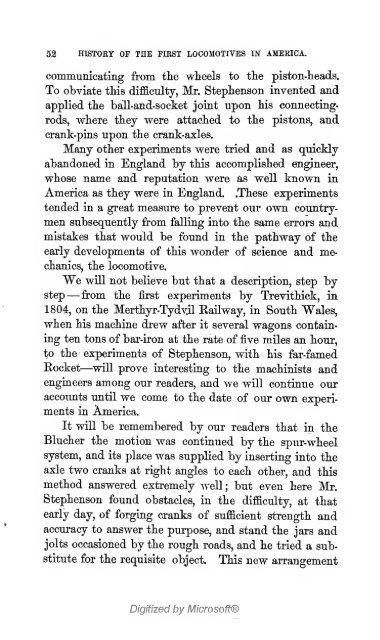The history of the first locomotives in America. From original ...
The history of the first locomotives in America. From original ...
The history of the first locomotives in America. From original ...
You also want an ePaper? Increase the reach of your titles
YUMPU automatically turns print PDFs into web optimized ePapers that Google loves.
53 HISTORY or THE FIRST LOCOMOTIVES IN AMERICA.<br />
communicat<strong>in</strong>g from tlie wteels to <strong>the</strong> piston-heads.<br />
To obviate tMs difficulty, Mr. Steplienson <strong>in</strong>vented and<br />
applied <strong>the</strong> ball-and-socket jo<strong>in</strong>t upon his connect<strong>in</strong>grods,<br />
where <strong>the</strong>y were attached to <strong>the</strong> pistons, and<br />
crank-p<strong>in</strong>s upon <strong>the</strong> crank-axles.<br />
Many o<strong>the</strong>r experiments were tried and as quickly<br />
abandoned <strong>in</strong> England by this accomplished eng<strong>in</strong>eer,<br />
whose name and reputation were as well known <strong>in</strong><br />
<strong>America</strong> as <strong>the</strong>y were <strong>in</strong> England. .<strong>The</strong>se experiments<br />
tended <strong>in</strong> a great measure to prevent our own countrymen<br />
subsequently from fall<strong>in</strong>g <strong>in</strong>to <strong>the</strong> same errors and<br />
mistakes that would be found <strong>in</strong> <strong>the</strong> pathway <strong>of</strong> <strong>the</strong><br />
early developments <strong>of</strong> this wonder <strong>of</strong> science and me-<br />
chanics, <strong>the</strong> locomotive.<br />
We will not believe but that a description, step by<br />
step— from <strong>the</strong> <strong>first</strong> experiments by Trevithick, <strong>in</strong><br />
1804, on <strong>the</strong> Merthyr-Tydvjl Kailway, <strong>in</strong> South "Wales,<br />
when his mach<strong>in</strong>e drew after it several wagons conta<strong>in</strong>-<br />
<strong>in</strong>g ten tons <strong>of</strong> bar-iron at <strong>the</strong> rate <strong>of</strong> five miles an hour,<br />
to <strong>the</strong> experiments <strong>of</strong> Stephenson, with his far-famed<br />
Eocket— ^will prove <strong>in</strong>terest<strong>in</strong>g to <strong>the</strong> mach<strong>in</strong>ists and<br />
eng<strong>in</strong>eers among our readers, and we will cont<strong>in</strong>ue our<br />
accounts until we come to <strong>the</strong> date <strong>of</strong> our own experi-<br />
ments <strong>in</strong> <strong>America</strong>.<br />
It will be remembered by our readers that <strong>in</strong> <strong>the</strong><br />
Blucher <strong>the</strong> motion was cont<strong>in</strong>ued by <strong>the</strong> spur-wheel<br />
system, and its place was supplied by <strong>in</strong>sert<strong>in</strong>g <strong>in</strong>to <strong>the</strong><br />
axle two cranks at right angles to each o<strong>the</strong>r, and this<br />
method answered extremely Avell; but even here Mr.<br />
Stephenson found obstacles, <strong>in</strong> <strong>the</strong> difficulty, at that<br />
early day, <strong>of</strong> forg<strong>in</strong>g cranks <strong>of</strong> sufficient strength and<br />
accuracy to answer <strong>the</strong> purpose, and stand <strong>the</strong> jars and<br />
jolts occasioned by <strong>the</strong> rough roads, and he tried a sub-<br />
stitute for <strong>the</strong> requisite object. This new arrangement<br />
Digitized by Micros<strong>of</strong>t®
















